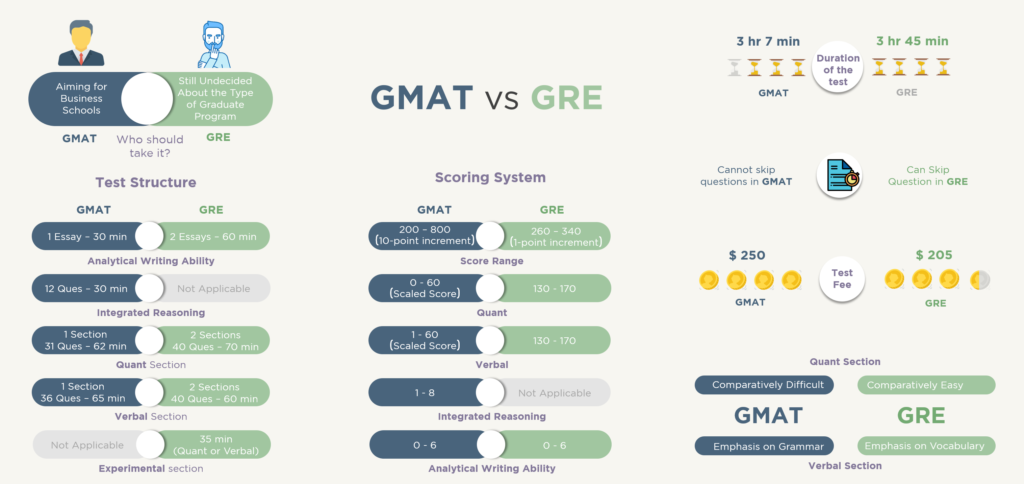If you’re considering pursuing a postgraduate degree and are unsure about which MBA program to invest in, understanding the disparity between the GMAT and the GRE is crucial. The GMAT (Graduate Management Admission Test) and the GRE (Graduate Record Examination) are two standardized tests that play pivotal roles in the admissions processes of graduate programs worldwide. While both exams assess skills vital for success in graduate school, they diverge in their formats, structures, and intended purposes. Let’s explore the disparities between the GMAT and the GRE across various aspects, including content, scoring systems, test formats, and program requirements.
Content:
The GMAT primarily evaluates skills pertinent to business and management education, while the GRE assesses more general academic abilities.
- GMAT Content: It consists of four sections: Analytical Writing Assessment (AWA), Integrated Reasoning (IR), Quantitative Reasoning, and Verbal Reasoning. These sections gauge mathematical proficiency, verbal reasoning skills, and the ability to interpret data and written material crucial for business studies.
- GRE Content: Comprising three main sections: Analytical Writing, Verbal Reasoning, and Quantitative Reasoning. While also evaluating mathematical abilities and verbal reasoning, the GRE’s content encompasses a broader spectrum of academic aptitude, suitable for various graduate disciplines beyond business.
Scoring System:
The GMAT and GRE employ different scoring scales and reporting policies.
- GMAT Scoring: Utilizes a scaled scoring system, providing scores ranging from 0 to 60 for Verbal and Quantitative Reasoning sections and 1 to 8 for Integrated Reasoning. The Analytical Writing Assessment receives scores from 0 to 6.
- GRE Scoring: Utilizes a scale of 130 to 170 for Verbal and Quantitative Reasoning sections and 0 to 6 for Analytical Writing. The total score ranges from 260 to 340.
Test Format:
The format of the GMAT and GRE varies concerning section order, timing, and adaptivity.
- GMAT Format: Follows a fixed structure with sections in a specific order. Test-takers have 3 hours and 30 minutes to complete the exam.
- GRE Format: Allows flexibility in section order and includes an unscored research section. Test-takers have 3 hours and 45 minutes.
Program Requirements:
GMAT and GRE acceptance varies across graduate programs, with certain fields and institutions favoring one test over the other.
- GMAT Program Requirements: Predominantly required for business and management programs, including MBA and specialized master’s degrees.
- GRE Program Requirements: Accepted by a broader range of graduate programs beyond business, spanning humanities, social sciences, natural sciences, engineering, and education.
In conclusion, while both the GMAT and the GRE assess cognitive abilities relevant to graduate education, they differ significantly in content, scoring, format, and program requirements. Prospective students should carefully evaluate their academic strengths, career aspirations, and the preferences of target programs to make an informed decision about which test to take. Ultimately, thorough preparation and understanding of each exam’s unique characteristics are essential for success in the graduate admissions process.
Learn more: https://bit.ly/gmatvsgre
How to write good MBA essays
MBA House | GMAT vs GRE
📧 [email protected] ⠀
🌐 https://mbahouse.com/




